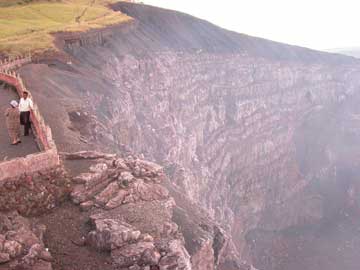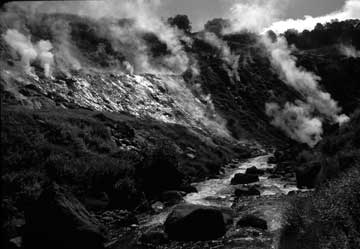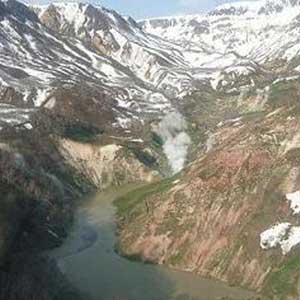|
NEWS NOTES — GEOPHENOMENA
Foam hushes volcano’s fury
Landslide partially buries Valley of Geysers
 Jay Chapman |
| Gases rise from the crater of Nicaragua’s “quiet” volcano Masaya. Although seismically active, Masaya rarely erupts. Its quiescence is likely due to a foamy layer of gases overlying the magma in a reservoir beneath the summit. |
Not all volcanoes are exhibitionists. Some rarely erupt, instead preferring to give off seismic rumbles and periodically emit steamy clouds of carbon dioxide, sulfur dioxide and hydrogen sulfide gases. Why these restless volcanoes don’t actually erupt — and what causes them to destabilize when they do — has been unclear, making it difficult to forecast their activity. However, one scientist is suggesting that a foamy layer of gases atop magma pooling deep inside Nicaragua’s “quiet” Masaya volcano may be preventing its eruption.
Previous studies of what might keep such volcanoes quiet have focused on how magma releases its gas. Most explosive volcanic eruptions are driven by a sudden, rapid expansion of gas trapped inside the magma. But models have shown that the gases can also be released more slowly: Buoyed by the gases dissolved within it, magma traveling upward through a narrow conduit toward the surface can slowly release its gas as it continues to rise and the pressure on it decreases. As the gas exits the magma during its upward rise, the magma becomes dense and sinks down again along the conduit’s walls, forestalling an eruption.
Another possibility is that magma collecting in a reservoir near the summit of a volcano can degas, forming a foamy layer at the top of the reservoir that keeps the volcano from erupting. The foam layer must be of a critical thickness (1 to 3 meters) to be stable, however — meaning that the gas leaving the magma below is balanced by the gas exiting the chamber through a narrow conduit to the surface, says volcanologist John Stix of McGill University in Montreal, Canada. If the foam layer is stable, then the volcano stays quiet, as models have shown, he says. If the foam layer in the chamber becomes unstable, however, the volcano can erupt explosively — as occurs at Hawaii’s Pu’u O’o or Italy’s Stromboli, for example.
To determine which of these methods is keeping Masaya quiet, Stix and colleagues took a closer look at the volcano. Masaya erupts only rarely, but is still considered an active system as it shows seismic activity and actively releases gas. Based on microgravity data — which show small changes in gravity measurements around a volcano due to movements of magma or an abundance of gas in the magma — gas-rich magma appears to have collected broadly beneath the summit of Masaya, across a region too wide to be accounted for by a narrow conduit alone. Furthermore, balancing magma thickness, the amount of gas flowing out of the magma and the size of the gas bubbles coming out of Masaya, the team found that the volcano does have a stable foam layer, as they reported in June in Geology.
However, the foam layer can’t be the sole cause of the volcano’s stability, Stix says. Because the microgravity data at Masaya suggest that the gas-rich magma region is both broad and deep, the volcano may have a magmatic system composed of both a shallow, foam-capped reservoir and a deeper conduit supplying the gas-rich magma, the authors say. This plumbing system, in which the gas-rich magma rises through the conduit to the reservoir, degasses to form the foam layer and then sinks back down again, thus keeping Masaya stable.
Even a quiet volcano like Masaya can erupt if its foam layer is destabilized, the team recognizes. Earthquakes that shake the walls of the reservoir, or change the width of the conduit feeding it, could help trigger a sudden influx of gas that could destabilize the foam and trigger an eruption.
BEFORE  |
AFTER  Images courtesy of Vadim Khegay/Vision of Kamchatka |
| A massive mudslide buried Kamchatka’s Valley of the Geysers in June. Researchers initially feared that all of the geysers were gone, but damage was less severe than originally thought. |
On June 3, one of Russia’s most famous natural wonders, Kamchatka’s Valley of Geysers, was partially buried by a landslide, which covered several of its geysers with water and mud. Despite initial concerns that the landslide may have permanently choked the valley’s geysers, Vladimir Leonov, academic secretary of the Institute of Volcanology and Seismology Far East Division of the Russian Academy of Sciences, said in a June 10 statement that the damage was less than feared. Although at least four of the valley’s biggest geysers were buried forever, the valley’s main geyser field, Vitrazh, escaped damage, and the largest geyser, Velikan (Giant), also survived.
Hidden deep in the mountains of the Kamchatka peninsula within the Kronotka Nature Reserve, the Valley of Geysers was discovered in 1941 by a Russian hydrologist and her guide, who were traveling along the Shumnaya River. They discovered a valley containing about 90 geysers, making it the second largest concentration of geysers in the world, after Yellowstone National Park in the United States. Finally opened to the public in 1991, the valley — whose geothermal waters are heated by the nearby volcano Kikhpinych — became a major tourist attraction for the remote peninsula.
The cause of the landslide is still unknown, but is likely due to natural erosion, Leonov said. The millions of cubic meters of mud created a natural dam for the Geysernaya River where it flows into the Shumnaya, briefly forming a lake and flooding several more geysers in the river valley, but then flowing away to reveal them again.

 Subscribe
Subscribe


